Comparison of Surface Solar Irradiance from Ground Observations and Satellite Data (1990–2016) over a Complex Orography Region (Piedmont—Northwest Italy)
Abstract
1. Introduction
2. Data and Methods
2.1. Ground-Based Observations
2.2. SARAH Dataset
2.3. CLARA Datset
2.4. Other Datasets
2.5. Error Indexes and Trend Analysis
- records with metadata giving evidence of shading;
- records for which the 2001–2016 SSI normal values changed by more than 5% because of the homogenisation procedure;
- records with seasonal average SSI below the following thresholds: 60 Wm−2 for winter, 180 Wm−2 for spring, 240 Wm−2 for summer, 100 Wm−2 for autumn, and 150 Wm−2 for the year. These thresholds were considered because metadata were not complete for all stations and it was therefore necessary to add a further condition to identify the records which may have been affected by shading problems not documented by the metadata.
3. Results
3.1. Comparison of Average SSI Values from Different Data Records
3.2. Common Variances and Mean Absolute Differences between SSI Records from Different Data Sources
3.2.1. Low OCI Station Sites
3.2.2. High OCI Station Sites
3.3. Trends of SSI Records from Different Data Sources
4. Discussion
5. Conclusions
Author Contributions
Funding
Conflicts of Interest
References
- Iqbal:, M. An Introduction to Solar Radiation; Academic Press: Cambridge, MA, USA, 1983; ISBN 9780323151818. [Google Scholar]
- Hartmann, D.L.; Ramanathan, V.; Berroir, A.; Hunt, G.E. Earth Radiation Budget Data and Climate Research. Rev. Geophys. 1986, 24, 439–468. [Google Scholar] [CrossRef]
- Wild, M.; Folini, D.; Schär, C.; Loeb, N.; Dutton, E.G.; König-Langlo, G. The global energy balance from a surface perspective. Clim. Dyn. 2013, 40, 3107–3134. [Google Scholar] [CrossRef]
- Stanhill, G.; Cohen, S. Global dimming: A review of the evidence for a widespread and significant reduction in global radiation with discussion of its probable causes and possible agricultural consequences. Agric. For. Meteorol. 2001, 107, 255–278. [Google Scholar] [CrossRef]
- Vyssoki, B.; Kapusta, N.D.; Praschak-Rieder, N.; Dorffner, G.; Willeit, M. Direct effect of sunshine on suicide. JAMA Psychiatry 2014, 71, 1231–1237. [Google Scholar] [CrossRef] [PubMed]
- Wild, M.; Ohmura, A.; Gilgen, H.; Rosenfeld, D. On the consistency of trends in radiation and temperature records and implications for the global hydrological cycle. Geophys. Res. Lett. 2004, 31. [Google Scholar] [CrossRef]
- Wild, M.; Folini, D.; Henschel, F.; Fischer, N.; Müller, B. Projections of long-term changes in solar radiation based on CMIP5 climate models and their influence on energy yields of photovoltaic systems. Sol. Energy 2015, 116, 12–24. [Google Scholar] [CrossRef]
- Mercado, L.M.; Bellouin, N.; Sitch, S.; Boucher, O.; Huntingford, C.; Wild, M.; Cox, P.M. Impact of changes in diffuse radiation on the global land carbon sink. Nature 2009, 458, 1014–1017. [Google Scholar] [CrossRef]
- Oerlemans, J. A 1 year record of global radiation and albedo in the ablation zone of Morteratschgletscher, Switzerland. J. Glaciol. 1998, 44, 231–238. [Google Scholar] [CrossRef]
- Wild, M. Global dimming and brightening: A review. J. Geophys. Res. 2009, 114, D00D16. [Google Scholar] [CrossRef]
- Wild, M. Decadal changes in radiative fluxes at land and ocean surfaces and their relevance for global warming. Wiley Interdiscip. Rev. Clim. Chang. 2016, 7, 91–107. [Google Scholar] [CrossRef]
- Liang, F.; Xia, X.A. Long-term trends in solar radiation and the associated climatic factors over China for 1961-2000. Ann. Geophys. 2005, 23, 2425–2432. [Google Scholar] [CrossRef]
- Long, C.N.; Dutton, E.G.; Augustine, J.A.; Wiscombe, W.; Wild, M.; McFarlane, S.A.; Flynn, C.J. Significant decadal brightening of downwelling shortwave in the continental United States. J. Geophys. Res. 2009, 114, D00D06. [Google Scholar] [CrossRef]
- Manara, V.; Beltrano, M.C.; Brunetti, M.; Maugeri, M.; Sanchez-Lorenzo, A.; Simolo, C.; Sorrenti, S. Sunshine duration variability and trends in Italy from homogenized instrumental time series (1936–2013). J. Geophys. Res. Atmos. 2015, 120, 3622–3641. [Google Scholar] [CrossRef]
- Manara, V.; Brunetti, M.; Celozzi, A.; Maugeri, M.; Sanchez-Lorenzo, A.; Wild, M. Detection of dimming/brightening in Italy from homogenized all-sky and clear-sky surface solar radiation records and underlying causes (1959–2013). Atmos. Chem. Phys. 2016, 16, 11145–11161. [Google Scholar] [CrossRef]
- Sanchez-Lorenzo, A.; Wild, M.; Brunetti, M.; Guijarro, J.A.; Hakuba, M.Z.; Calbó, J.; Mystakidis, S.; Bartok, B. Reassessment and update of long-term trends in downward surface shortwave radiation over Europe (1939–2012). J. Geophys. Res. Atmos. 2015, 120, 9555–9569. [Google Scholar] [CrossRef]
- Wang, Y.; Wild, M. A new look at solar dimming and brightening in China. Geophys. Res. Lett. 2016, 43, 11777–11785. [Google Scholar] [CrossRef]
- Wang, K.C.; Dickinson, R.E.; Wild, M.; Liang, S. Atmospheric impacts on climatic variability of surface incident solar radiation. Atmos. Chem. Phys. 2012, 12, 9581–9592. [Google Scholar] [CrossRef]
- Soni, V.K.; Pandithurai, G.; Pai, D.S. Evaluation of long-term changes of solar radiation in India. Int. J. Climatol. 2012, 32, 540–551. [Google Scholar] [CrossRef]
- Driemel, A.; Augustine, J.; Behrens, K.; Colle, S.; Cox, C.; Cuevas-Agulló, E.; Denn, F.M.; Duprat, T.; Fukuda, M.; Grobe, H.; et al. Baseline Surface Radiation Network (BSRN): Structure and data description (1992–2017). Earth Syst. Sci. Data 2018, 10, 1491–1501. [Google Scholar] [CrossRef]
- Wild, M.; Ohmura, A.; Schär, C.; Müller, G.; Folini, D.; Schwarz, M.; Zyta Hakuba, M.; Sanchez-Lorenzo, A. The Global Energy Balance Archive (GEBA) version 2017: A database for worldwide measured surface energy fluxes. Earth Syst. Sci. Data 2017, 9, 601–613. [Google Scholar] [CrossRef]
- Storelvmo, T.; Heede, U.K.; Leirvik, T.; Phillips, P.C.B.; Arndt, P.; Wild, M. Lethargic Response to Aerosol Emissions in Current Climate Models. Geophys. Res. Lett. 2018, 45, 9814–9823. [Google Scholar] [CrossRef]
- Huang, G.; Li, Z.; Li, X.; Liang, S.; Yang, K.; Wang, D.; Zhang, Y. Estimating surface solar irradiance from satellites: Past, present, and future perspectives. Remote Sens. Environ. 2019, 233, 111371. [Google Scholar] [CrossRef]
- Pfeifroth, U.; Kothe, S.; Trentmann, J.; Hollmann, R.; Fuchs, P.; Kaiser, J.; Werscheck, M. Surface Radiation Data Set—Heliosat (SARAH)—Edition 2.1, Satellite Application Facility on Climate Monitoring. CM-SAF 2019. [Google Scholar] [CrossRef]
- Pfeifroth, U.; Kothe, S.; Müller, R.; Trentmann, J.; Hollmann, R.; Fuchs, P.; Werscheck, M. Surface Radiation Data Set—Heliosat (SARAH)—Edition 2, Satellite Application Facility on Climate Monitoring. CM-SAF 2017. [Google Scholar] [CrossRef]
- Karlsson, K.G.; Anttila, K.; Trentmann, J.; Stengel, M.; Meirink, J.F.; Devasthale, A.; Hanschmann, T.; Kothe, S.; Jääskeläinen, E.; Sedlar, J.; et al. CLARA-A2: CM SAF cLoud, Albedo and surface RAdiation dataset from AVHRR data—Edition 2, Satellite Application Facility on Climate Monitoring. CM-SAF 2017. [Google Scholar] [CrossRef]
- Karlsson, K.G.; Anttila, K.; Trentmann, J.; Stengel, M.; Fokke Meirink, J.; Devasthale, A.; Hanschmann, T.; Kothe, S.; Jaäskelaïnen, E.; Sedlar, J.; et al. CLARA-A2: The second edition of the CM SAF cloud and radiation data record from 34 years of global AVHRR data. Atmos. Chem. Phys. 2017, 17, 5809–5828. [Google Scholar] [CrossRef]
- Pfeifroth, U.; Sanchez-Lorenzo, A.; Manara, V.; Trentmann, J.; Hollmann, R. Trends and Variability of Surface Solar Radiation in Europe Based On Surface- and Satellite-Based Data Records. J. Geophys. Res. Atmos. 2018, 123, 1735–1754. [Google Scholar] [CrossRef]
- Urraca, R.; Gracia-amillo, A.M.; Koubli, E.; Huld, T.; Trentmann, J.; Riihelä, A.; Lindfors, A.V.; Palmer, D.; Gottschalg, R.; Antonanzas-torres, F. Remote Sensing of Environment Extensive validation of CM SAF surface radiation products over Europe. Remote Sens. Environ. 2017, 199, 171–186. [Google Scholar] [CrossRef]
- Montero-Martín, J.; Antón, M.; Vaquero-martínez, J.; Sanchez-lorenzo, A. Comparison of long-term solar radiation trends from CM SAF satellite products with ground-based data at the Iberian Peninsula for the period 1985–2015. Atmos. Res. 2020, 236, 104839. [Google Scholar] [CrossRef]
- Wang, Y.; Trentmann, J.; Yuan, W.; Wild, M. Validation of CM SAF CLARA-A2 and SARAH-E surface solar radiation datasets over China. Remote Sens. 2018, 10, 1977. [Google Scholar] [CrossRef]
- Manara, V.; Bassi, M.; Brunetti, M.; Cagnazzi, B.; Maugeri, M. 1990–2016 surface solar radiation variability and trend over the Piedmont region (northwest Italy). Theor. Appl. Climatol. 2019, 136, 849–862. [Google Scholar] [CrossRef]
- Manara, V.; Brunetti, M.; Maugeri, M.; Sanchez-Lorenzo, A.; Wild, M. Sunshine duration and global radiation trends in Italy (1959–2013): To what extent do they agree? J. Geophys. Res. 2017, 122, 4312–4331. [Google Scholar] [CrossRef]
- Manara, V.; Brunetti, M.; Gilardoni, S.; Landi, T.C.; Maugeri, M. 1951–2017 changes in the frequency of days with visibility higher than 10 km and 20 km in Italy. Atmos. Environ. 2019, 214, 116861. [Google Scholar] [CrossRef]
- Craddock, J.M. Methods of comparing annual rainfall records for climatic purposes. Weather 1979, 34, 332–346. [Google Scholar] [CrossRef]
- Manara, V.; Brunetti, M.; Maugeri, M.; Sanchez-Lorenzo, A.; Wild, M. Homogenization of a surface solar radiation dataset over Italy. In Proceedings of the Radiation processes in the atmosphere And Ocean (IRS 2016)—AIP Conference Proceeding, Auckland, New Zealand, 12–22 April 2016; AIP Publishing: Melville, NY, USA, 2017; Volume 1810, pp. 090004-1–090004-4. [Google Scholar]
- Trentmann, J.; Pfeifroth, U.; Hollmann, R.; Werscheck, M. Algorithm Theoretical Baseline Document ICDR SEVIRI Radiation Based on SARAH-2 Methods. EUMETSAT Satellite Application Facility on Climate Monitoring. 2018. Available online: https://www.cmsaf.eu/SharedDocs/Literatur/document/2018/saf_cm_dwd_icdr_sev_rad_atbd_1_3_pdf.pdf?__blob=publicationFile (accessed on 26 November 2020).
- Posselt, R.; Mueller, R.W.; Stöckli, R.; Trentmann, J. Remote sensing of solar surface radiation for climate monitoring - the CM-SAF retrieval in international comparison. Remote Sens. Environ. 2012, 118, 186–198. [Google Scholar] [CrossRef]
- Mueller, R.; Behrendt, T.; Hammer, A.; Kemper, A. A new algorithm for the satellite-based retrieval of solar surface irradiance in spectral bands. Remote Sens. 2012, 4, 622–647. [Google Scholar] [CrossRef]
- Pfeifroth, U.; Trentmann, J.; Kothe, S.; Hollmann, R.; Werscheck, M. Validation Report: Meteosat Solar Surface Radiation and Effective Cloud Albedo Climate Data Record SARAH-2.1 climate data records. EUMETSAT Satell. Appl. Facil. Clim. Monit. 2019. SAF/CM/DWD. [Google Scholar] [CrossRef]
- USGS GTOPO 30 Digital Elevation Model. Available online: https://www.usgs.gov/centers/eros/science/usgs-eros-archive-digital-elevation-global-30-arc-second-elevation-gtopo30?qt-science_center_objects=0#qt-science_center_objects (accessed on 26 November 2020).
- Dybbroe, A.; Karlsson, K.-G.; Thoss, A. NWCSAF AVHRR cloud detection and analysis using dynamic thresholds and radiative transfer modeling. Part I: Algorithm description. J. Appl. Meteorol. 2005, 44, 39–53. [Google Scholar] [CrossRef]
- Mueller, R.W.; Matsoukas, C.; Gratzki, A.; Behr, H.D.; Hollmann, R. The CM-SAF operational scheme for the satellite based retrieval of solar surface irradiance—A LUT based eigenvector hybrid approach. Remote Sens. Environ. 2009, 113, 1012–1024. [Google Scholar] [CrossRef]
- Diekmann, F.J.; Happ, S.; Koln, M.R.; Benesch, W.; Czeplak, G.; Kasten, F. An operational estimate of global irradiance at ground level from METEOSAT data: Results from 1985 to 1987. Meteorol. Rdsch. 1988, 41, 65–79. [Google Scholar]
- Karlsson, K.G.; Riihelä, A.; Müller, R.; Meirink, J.F.; Sedlar, J.; Stengel, M.; Lockhoff, M.; Trentmann, J.; Kaspar, F.; Hollmann, R.; et al. CLARA-A1: A cloud, albedo, and radiation dataset from 28 yr of global AVHRR data. Atmos. Chem. Phys. 2013, 13, 5351–5367. [Google Scholar] [CrossRef]
- Gelaro, R.; McCarty, W.; Suárez, M.J.; Todling, R.; Molod, A.; Takacs, L.; Randles, C.A.; Darmenov, A.; Bosilovich, M.G.; Reichle, R.; et al. The Modern-Era Retrospective Analysis for Research and Applications, Version 2 (MERRA-2). J. Clim. 2017, 30, 5419–5454. [Google Scholar] [CrossRef] [PubMed]
- Gafurov, A.; Bárdossy, A. Cloud removal methodology from MODIS snow cover product. Hydrol. Earth Syst. Sci. 2009, 13, 1361–1373. [Google Scholar] [CrossRef]
- Tadono, T.; Ishida, H.; Oda, F.; Naito, S.; Minakawa, K.; Iwamoto, H. Precise Global DEM Generation by ALOS PRISM. ISPRS Ann. Photogramm. Remote Sens. Spat. Inf. Sci. 2014, II–4, 71–76. [Google Scholar] [CrossRef]
- Sen, P.K. Estimates of the Regression Coefficient Based on Kendall’s Tau. J. Am. Stat. Assoc. 1968, 63, 1379–1389. [Google Scholar] [CrossRef]
- Theil, H. A rank-invariant method of linear and polynomical regression analysis. In Advanced Studies in Theoretical and Applied Econometrics; Part I; Springer: Berlin/Heidelberg, Germany, 1950; pp. 386–392. [Google Scholar]
- Sneyers, R. On the use of statistical analysis for the objective determination of climate change. Meteorol. Zeitschrift 1992, 1, 247–256. [Google Scholar] [CrossRef]
- Trentmann, J.; Kothe, S.; Hollmann, R.; Werscheck, M. Validation Report CM SAF Cloud, Albedo, Radiation data record, AVHRR-based, Edition 2 (CLARA-A2). EUMETSAT Satellite Application Facility on Climate Monitoring. 2016. Available online: https://www.cmsaf.eu/SharedDocs/Literatur/document/2016/saf_cm_fmi_val_gac_sal_2_1_pdf.html (accessed on 26 November 2020).
- Haiden, T.; Trentmann, J. Verification of cloudiness and radiation forecasts in the greater Alpine region. Meteorol. Zeitschrift 2016, 25, 3–15. [Google Scholar] [CrossRef]
- Hakuba, M.Z.; Folini, D.; Sanchez-Lorenzo, A.; Wild, M. Spatial representativeness of ground-based solar radiation measurements. J. Geophys. Res. Atmos. 2013, 118, 8585–8597. [Google Scholar] [CrossRef]
- Huang, G.; Li, X.; Huang, C.; Liu, S.; Ma, Y.; Chen, H. Representativeness errors of point-scale ground-based solar radiation measurements in the validation of remote sensing products. Remote Sens. Environ. 2016, 181, 198–206. [Google Scholar] [CrossRef]
- Carbone, C.; Decesari, S.; Mircea, M.; Giulianelli, L.; Finessi, E.; Rinaldi, M.; Fuzzi, S.; Marinoni, A.; Duchi, R.; Perrino, C.; et al. Size-resolved aerosol chemical composition over the Italian Peninsula during typical summer and winter conditions. Atmos. Environ. 2010, 44, 5269–5278. [Google Scholar] [CrossRef]
- Baltensperger, U.; Gäggeler, H.W.; Jost, D.T.; Emmenegger, M.; Nägeli, W. Continuous background aerosol monitoring with the epiphaniometer. Atmos. Environ. Part A Gen. Top. 1991, 25, 629–634. [Google Scholar] [CrossRef]
- Lugauer, M.; Baltensperger, U.; Furger, M.; Gäggeler, H.W.; Jost, D.T.; Schwikowski, M.; Wanner, H. Aerosol transport to the high Alpine sites Jungfraujoch (3454 m asl) and Colle Gnifetti (4452 m asl). Tellus Ser. B Chem. Phys. Meteorol. 1998, 50, 76–92. [Google Scholar] [CrossRef]
- Alexandri, G.; Georgoulias, A.K.; Meleti, C.; Balis, D.; Kourtidis, K.A.; Sanchez-Lorenzo, A.; Trentmann, J.; Zanis, P. A high resolution satellite view of surface solar radiation over the climatically sensitive region of Eastern Mediterranean. Atmos. Res. 2017, 188, 107–121. [Google Scholar] [CrossRef]
- Senese, A.; Manara, V.; Maugeri, M.; Diolaiuti, G.A. Comparing Measured Incoming Shortwave and Longwave Radiation on a Glacier Surface with Estimated Records from Satellite and Off - Glacier Observations: A Case Study for the Forni Glacier, Italy. Remote Sens. 2020, 12, 3719. [Google Scholar] [CrossRef]
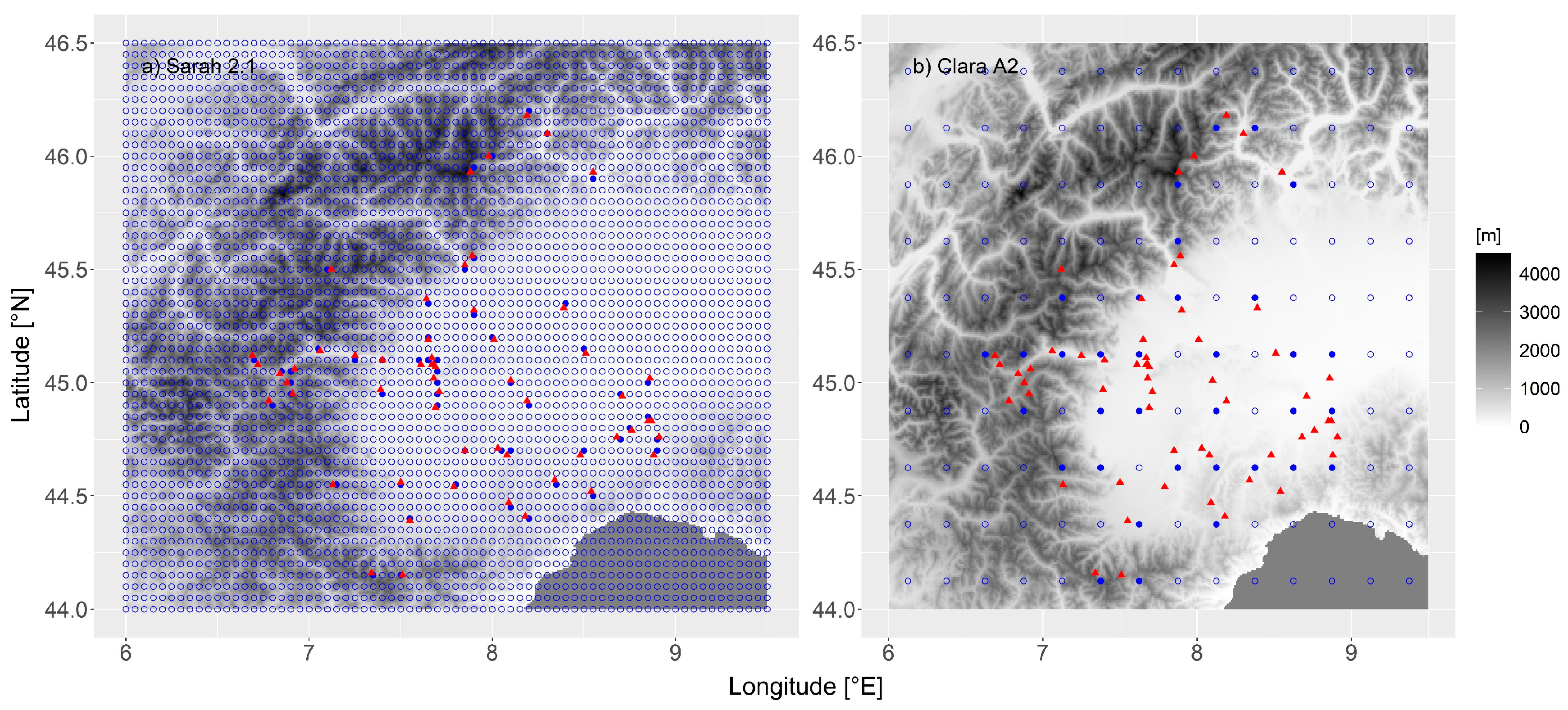
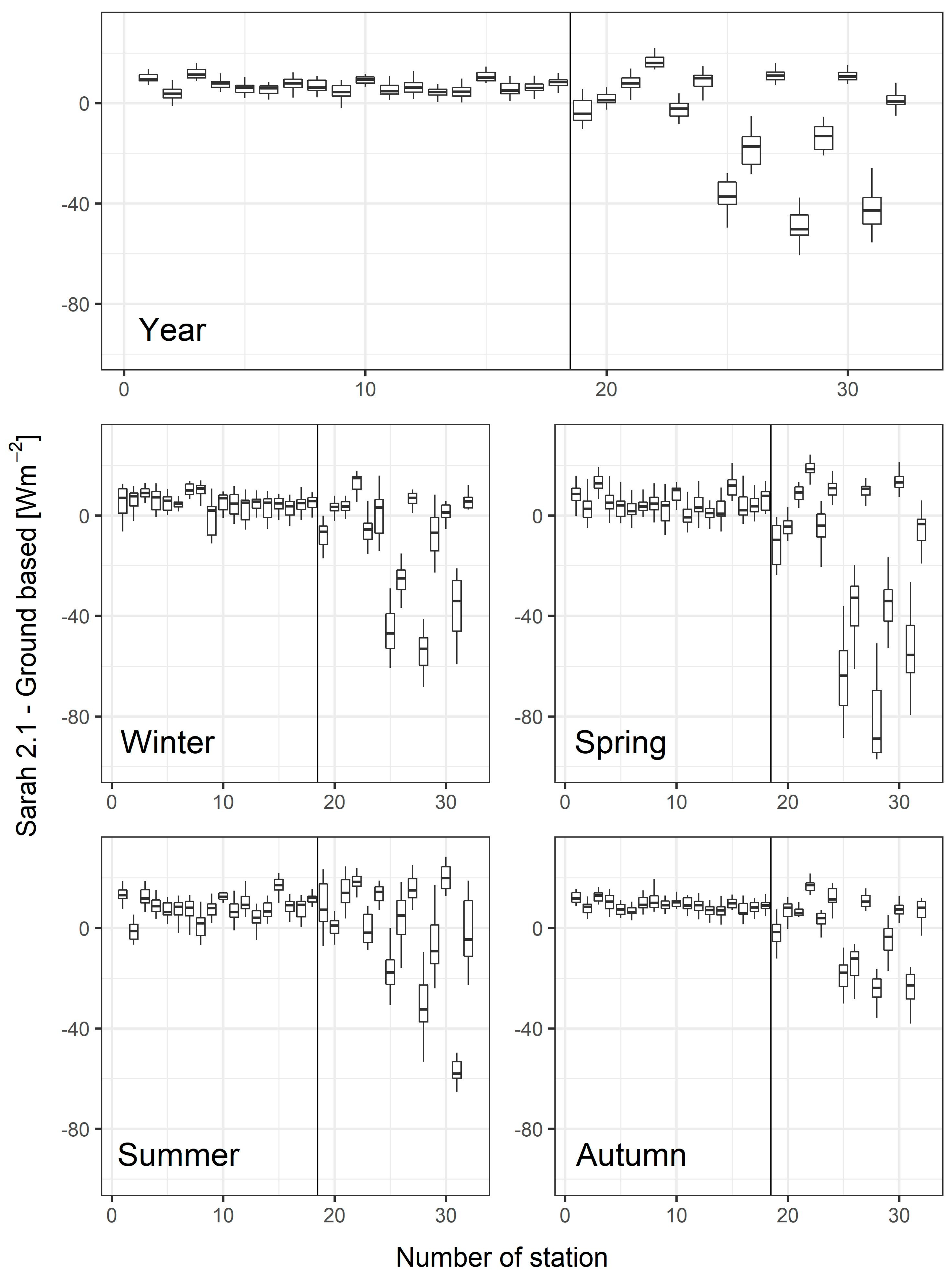
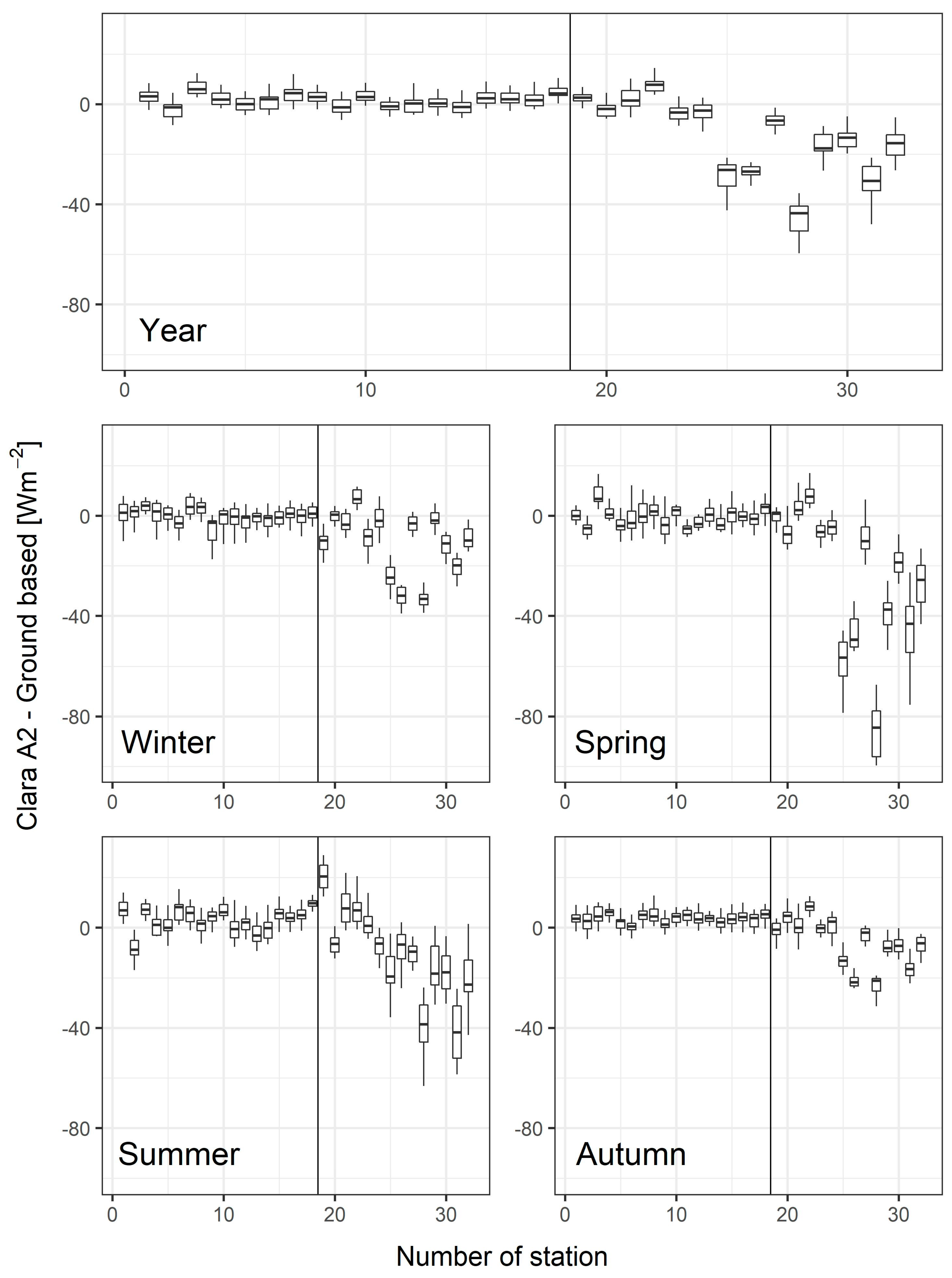

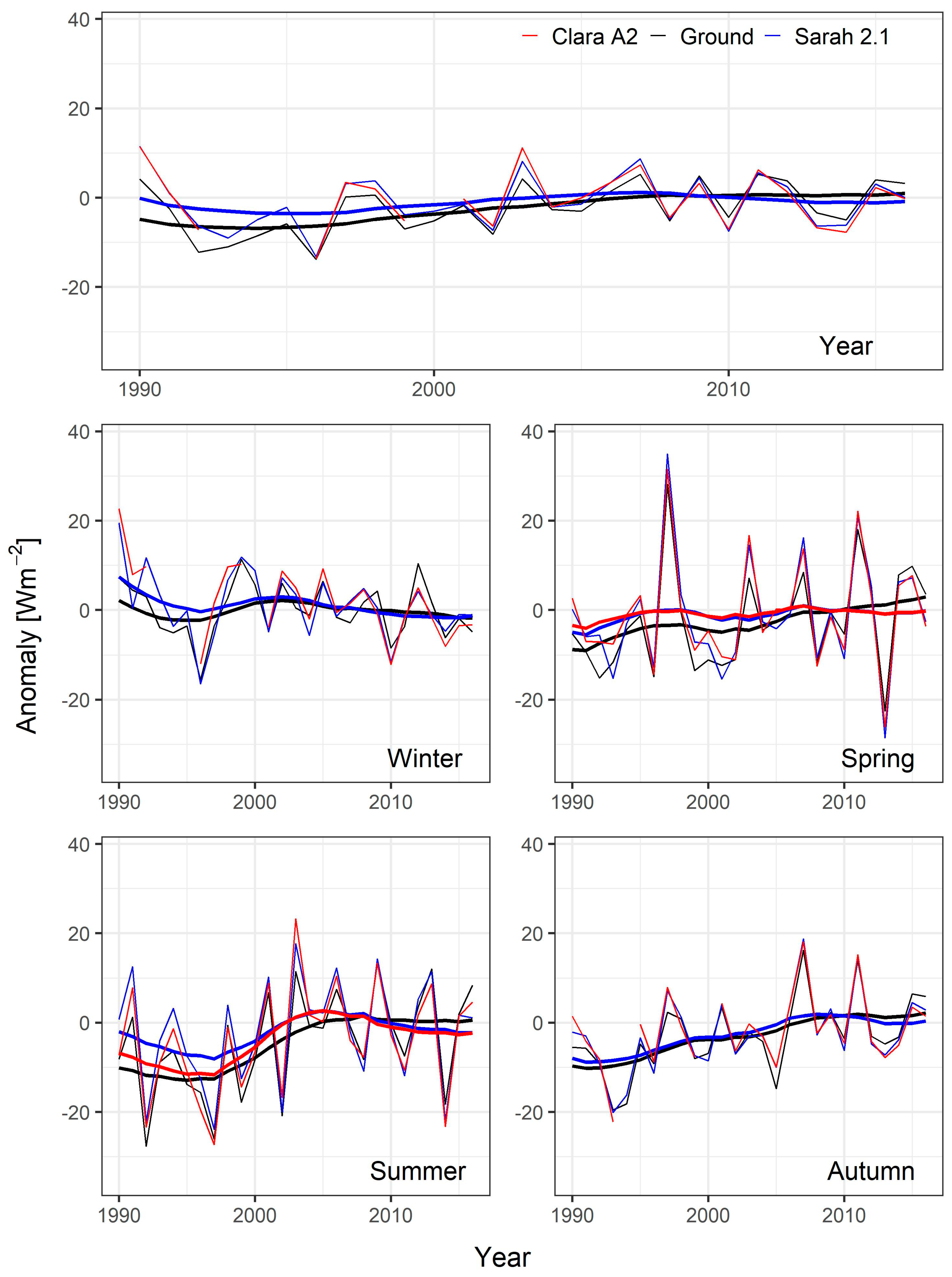

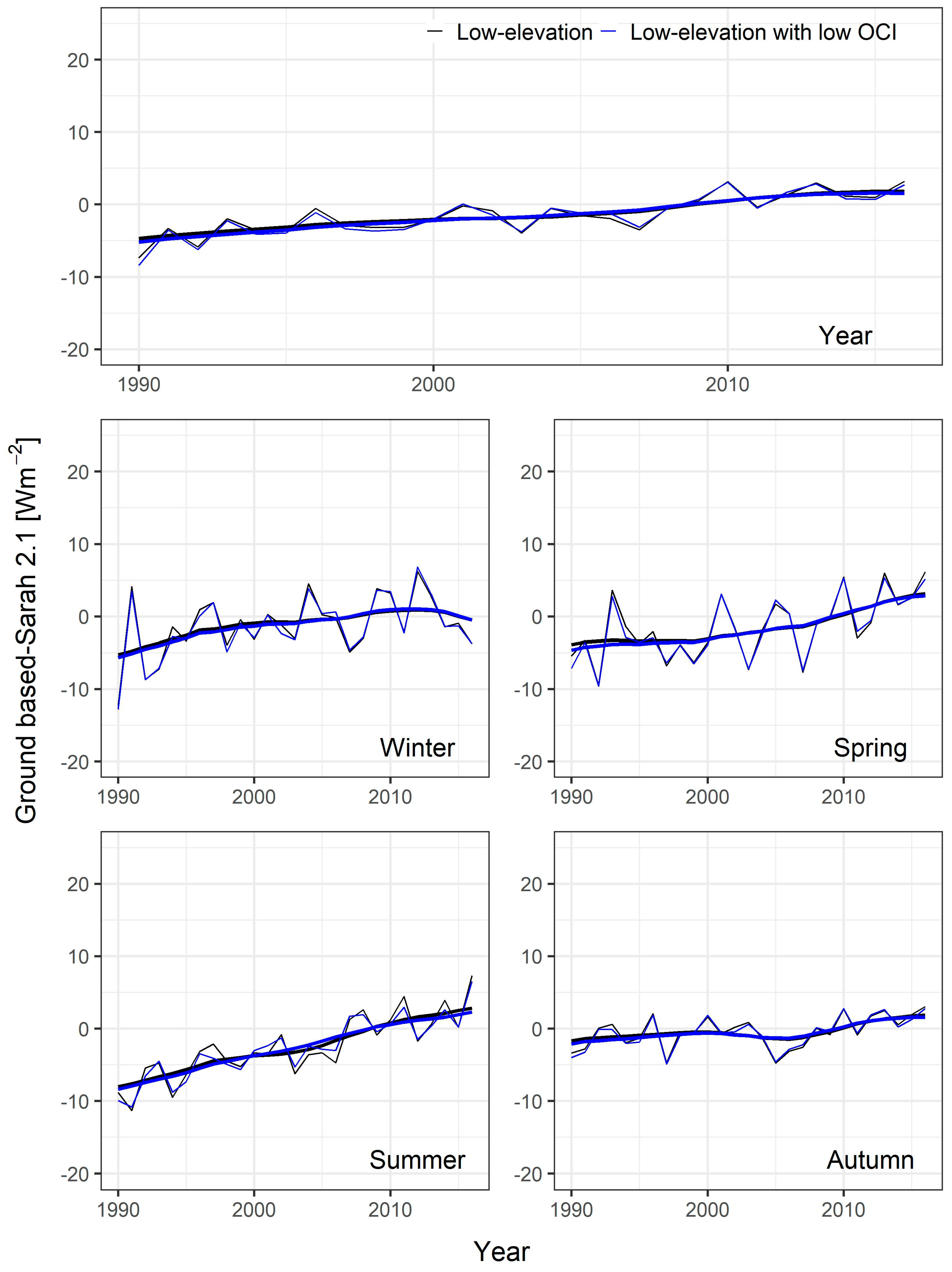
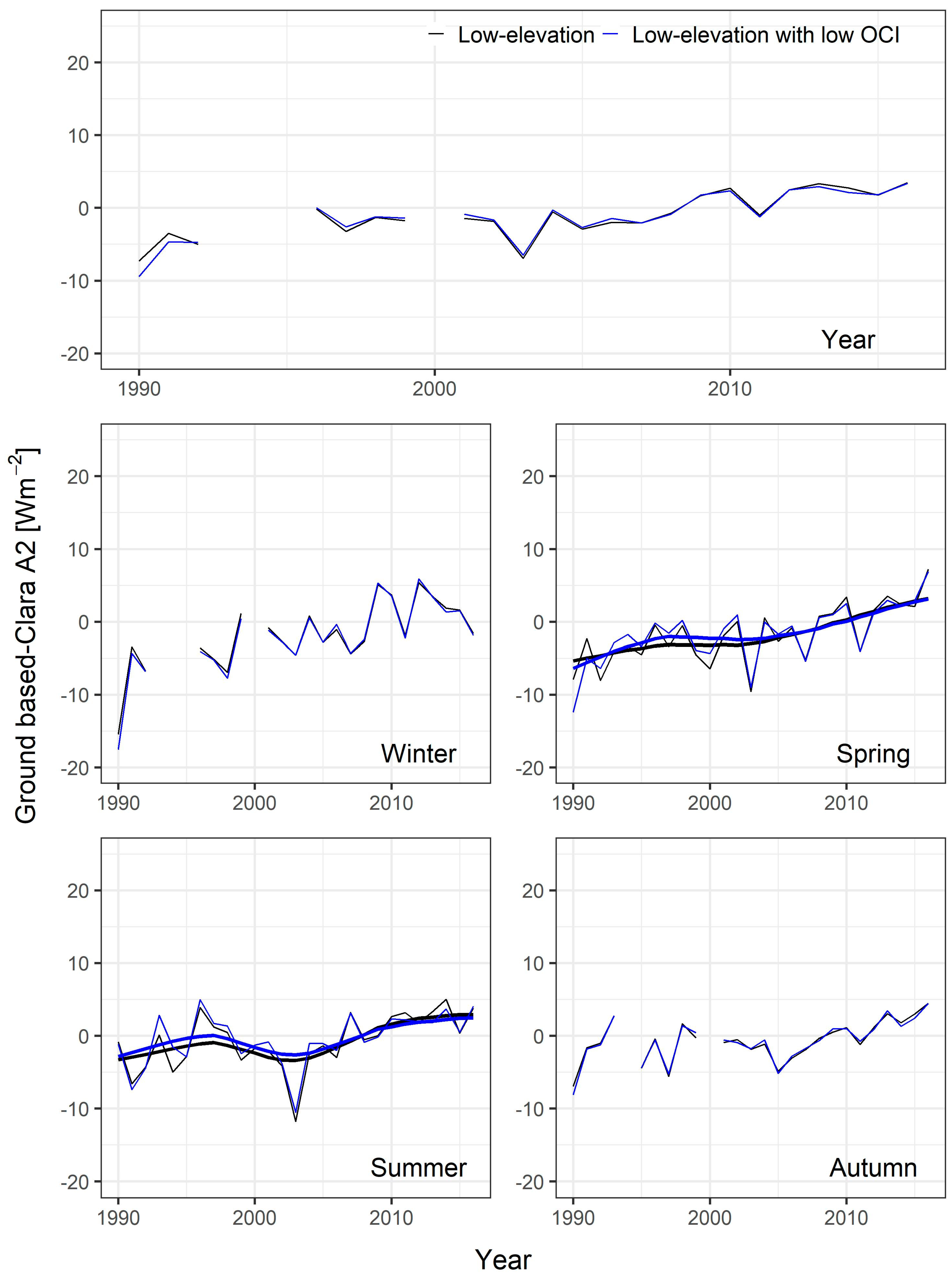
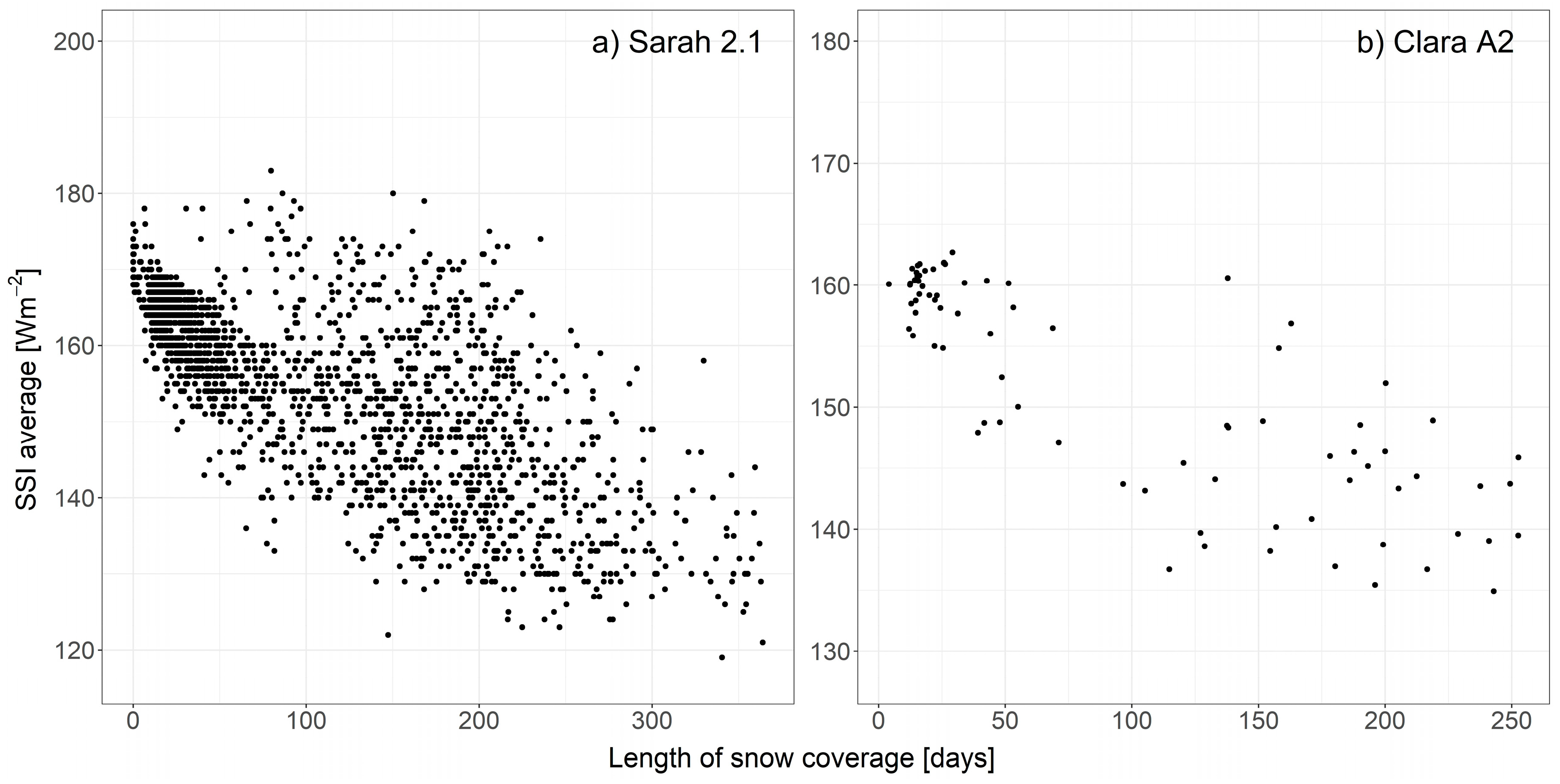

| Station Name | Longitude (E°) | Latitude (N°) | Altitude (m) | OCI (m) | SSI Ground Stations (Wm−2) | SSI SARAH-2.1 (Wm−2) | SSI CLARA-A2 (Wm−2) | Stations Considered in Figure 2 and Figure 3 |
|---|---|---|---|---|---|---|---|---|
| Isola San Antonio | 8.855 | 45.022 | 77 | 10 | 157.0 | 168.0 | 161.0 | 1 |
| Bauducchi | 7.710 | 44.961 | 226 | 11 | 164.5 | 168.2 | 162.1 | 2 |
| Carmagnola | 7.688 | 44.887 | 232 | 11 | 159.8 | 168.1 | 162.1 | |
| Casale Monferrato | 8.505 | 45.133 | 118 | 17 | 170.8 | 167.0 | 161.4 | |
| Vercelli | 8.391 | 45.326 | 132 | 17 | 154.8 | 166.6 | 161.1 | 3 |
| Alessandria Lobbi | 8.705 | 44.938 | 88 | 32 | 154.0 | 167.8 | 159.8 | |
| Basaluzzo | 8.682 | 44.763 | 128 | 32 | 157.6 | 165.4 | 159.8 | 4 |
| Asti | 8.192 | 44.919 | 175 | 34 | 162.4 | 168.1 | 162.4 | 5 |
| Caselle | 7.652 | 45.192 | 300 | 60 | 148.7 | 166.6 | 160.0 | |
| Torino Consolata | 7.679 | 45.077 | 290 | 60 | 139.0 | 162.7 | 160.0 | |
| Torino Alenia | 7.612 | 45.081 | 320 | 60 | 159.1 | 164.4 | 160.0 | 6 |
| Torino B. Pastore | 7.674 | 45.080 | 240 | 60 | 127.7 | 163.9 | 160.0 | |
| Torino R. Romoli | 7.671 | 45.113 | 270 | 60 | 156.0 | 163.9 | 160.0 | 7 |
| Verolengo | 8.012 | 45.186 | 163 | 62 | 159.5 | 166.1 | 162.3 | 8 |
| Montechiaro d’Asti | 8.102 | 45.008 | 200 | 62 | 162.1 | 167.5 | 162.3 | |
| Fossano | 7.788 | 44.540 | 403 | 73 | 163.3 | 167.9 | 162.6 | 9 |
| Bra | 7.853 | 44.702 | 285 | 73 | 159.3 | 168.5 | 162.6 | 10 |
| Torino Vallere | 7.675 | 45.018 | 239 | 76 | 133.4 | 167.5 | 160.0 | |
| Castellar Ponzano | 8.848 | 44.828 | 146 | 100 | 160.4 | 165.6 | 159.8 | 11 |
| Novi Ligure | 8.758 | 44.787 | 162 | 100 | 159.7 | 166.0 | 159.8 | 12 |
| Sardigliano | 8.908 | 44.757 | 320 | 100 | 159.6 | 163.7 | 159.8 | 13 |
| Spineto Scrivia | 8.870 | 44.833 | 187 | 100 | 160.8 | 165.6 | 159.8 | 14 |
| Candia | 7.900 | 45.322 | 226 | 103 | 156.9 | 167.7 | 159.4 | 15 |
| Mombaldone B. | 8.336 | 44.570 | 187 | 116 | 130.9 | 166.6 | 162.3 | |
| Acqui Terme | 8.481 | 44.680 | 215 | 116 | 160.1 | 165.7 | 162.4 | 16 |
| Torino G. Reali | 7.690 | 45.072 | 239 | 130 | 144.0 | 164.7 | 160.0 | |
| Bergalli | 8.183 | 44.408 | 385 | 146 | 159.6 | 164.1 | 161.0 | |
| Mombarcaro | 8.086 | 44.469 | 896 | 146 | 152.5 | 165.9 | 161.0 | |
| Alba Tanaro | 8.029 | 44.706 | 172 | 153 | 161.5 | 167.6 | 163.3 | 17 |
| Treiso | 8.083 | 44.678 | 376 | 153 | 158.5 | 166.7 | 163.3 | 18 |
| Ponzone B. Berton | 8.540 | 44.519 | 773 | 171 | 158.3 | 155.0 | 160.8 | 19 |
| Arquata Scrivia | 8.882 | 44.684 | 325 | 182 | 160.5 | 162.2 | 158.3 | 20 |
| Pallanza | 8.550 | 45.925 | 202 | 202 | 153.6 | 161.5 | 155.6 | 21 |
| Cumiana | 7.392 | 44.965 | 327 | 225 | 151.7 | 168.2 | 159.4 | 22 |
| Cuneo C. Com. | 7.547 | 44.388 | 550 | 302 | 162.5 | 160.4 | 158.8 | 23 |
| Costigliole Saluzzo | 7.497 | 44.559 | 440 | 361 | 159.6 | 168.3 | 156.6 | 24 |
| Sestriere Banchetta | 6.911 | 44.954 | 2480 | 394 | 177.8 | 141.2 | 148.9 | 25 |
| Colle Bercia | 6.784 | 44.922 | 2200 | 394 | 174.9 | 144.4 | 148.9 | |
| Rocca dell’Abisso | 7.503 | 44.143 | 2753 | 403 | 177.6 | 159.4 | 150.0 | 26 |
| Avigliana | 7.396 | 45.095 | 340 | 436 | 159.1 | 170.1 | 153.0 | 27 |
| Gran Vaudala | 7.119 | 45.496 | 3272 | 454 | 183.6 | 135.0 | 137.9 | 28 |
| Belmonte | 7.638 | 45.372 | 687 | 465 | 151.6 | 170.6 | 149.3 | |
| Prerichard | 6.718 | 45.076 | 1353 | 473 | 164.7 | 166.0 | 145.7 | |
| Camini Frejus | 6.690 | 45.118 | 1740 | 473 | 133.4 | 166.0 | 145.7 | |
| Diga del Chiotas | 7.335 | 44.162 | 2020 | 506 | 150.5 | 143.4 | 147.4 | |
| Pian delle Baracche | 7.134 | 44.550 | 2135 | 538 | 155.4 | 157.0 | 140.7 | |
| Domodossola | 8.303 | 46.104 | 252 | 549 | 144.7 | 154.3 | 144.2 | |
| Lago Pilone | 6.877 | 45.003 | 2280 | 576 | 162.6 | 149.0 | 146.6 | 29 |
| Le Selle | 6.918 | 45.055 | 1980 | 576 | 166.4 | 159.6 | 146.6 | |
| Gad | 6.841 | 45.044 | 1065 | 576 | 190.0 | 164.8 | 146.6 | |
| Andrate Pinalba | 7.893 | 45.562 | 1580 | 636 | 142.2 | 160.9 | 143.8 | |
| Borgofranco d’Ivrea | 7.849 | 45.515 | 337 | 636 | 157.3 | 168.2 | 143.7 | 30 |
| Lago Paione | 8.191 | 46.177 | 2269 | 675 | 134.9 | 148.9 | 137.4 | |
| Cap. Margherita | 7.877 | 45.927 | 4560 | 679 | 170.6 | 128.2 | 139.3 | 31 |
| Passo del Moro | 7.978 | 45.998 | 2820 | 679 | 177.4 | 132.1 | 139.3 | |
| Borgone | 7.245 | 45.118 | 400 | 702 | 154.5 | 161.7 | 144.7 | |
| Pietrastretta | 7.055 | 45.143 | 520 | 702 | 160.8 | 161.6 | 144.7 | 32 |
| Year | Winter | Spring | Summer | Autumn | |
|---|---|---|---|---|---|
| All stations | 6.7 ± 7.4 | 3.9 ± 8.3 | 8.6 ± 9.8 | 8.3 ± 10.4 | 5.8 ± 4.6 |
| Low OCI stations | 5.2 ± 1.4 | 5.1 ± 1.0 | 5.3 ± 2.7 | 5.0 ± 2.9 | 5.4 ± 1.5 |
| High OCI stations | 8.3 ± 10.5 | 2.6 ± 12.0 | 12.3 ± 13.1 | 12.0 ± 14.0 | 6.2 ± 6.6 |
| Anomaly Temporal Resolution | Period Considered | Low OCI Station Sites | High OCI Station Sites | ||||||
|---|---|---|---|---|---|---|---|---|---|
| Common Variance | MAD (Wm−2) | Common Variance | MAD (Wm−2) | ||||||
| SARAH-2.1—Ground Stations | CLARA-A2—Ground Stations | SARAH-2.1—Ground Stations | CLARA-A2—Ground Stations | SARAH-2.1—Ground Stations | CLARA-A2—Ground Stations | SARAH-2.1—Ground Stations | CLARA-A2—Ground Stations | ||
| Daily | D-J-F | 0.84 | 0.84 | 9.56 | 10.44 | 0.48 | 0.68 | 19.76 | 14.38 |
| M-A-M | 0.95 | 0.91 | 13.45 | 17.33 | 0.73 | 0.77 | 30.33 | 28.47 | |
| J-J-A | 0.90 | 0.84 | 14.73 | 19.71 | 0.78 | 0.75 | 27.09 | 29.78 | |
| S-O-N | 0.93 | 0.88 | 9.49 | 12.83 | 0.77 | 0.79 | 18.26 | 17.89 | |
| All data | 0.92 | 0.87 | 11.83 | 15.23 | 0.73 | 0.76 | 23.85 | 22.81 | |
| Monthly | D-J-F | 0.68 | 0.69 | 4.86 | 4.73 | 0.38 | 0.65 | 8.68 | 5.07 |
| M-A-M | 0.89 | 0.87 | 5.58 | 5.87 | 0.62 | 0.65 | 10.97 | 10.13 | |
| J-J-A | 0.82 | 0.82 | 6.03 | 6.00 | 0.66 | 0.64 | 10.46 | 9.93 | |
| S-O-N | 0.89 | 0.86 | 3.50 | 4.05 | 0.73 | 0.76 | 6.88 | 5.80 | |
| All data | 0.84 | 0.83 | 4.99 | 5.20 | 0.61 | 0.66 | 9.24 | 7.86 | |
| Seasonal | Winter | 0.64 | 0.60 | 3.81 | 4.09 | 0.39 | 0.61 | 6.60 | 3.93 |
| Spring | 0.82 | 0.82 | 4.61 | 4.15 | 0.53 | 0.55 | 7.64 | 7.42 | |
| Summer | 0.80 | 0.83 | 4.73 | 4.12 | 0.60 | 0.57 | 7.87 | 7.64 | |
| Autumn | 0.89 | 0.77 | 2.44 | 2.93 | 0.72 | 0.73 | 4.40 | 3.57 | |
| All data | 0.79 | 0.79 | 3.90 | 3.84 | 0.54 | 0.57 | 6.60 | 5.81 | |
| Annual | All data | 0.73 | 0.69 | 2.88 | 2.97 | 0.51 | 0.44 | 4.13 | 4.02 |
| Considered Sites | Data | Month | Winter | Spring | Summer | Autumn | Year |
|---|---|---|---|---|---|---|---|
| Low-elevation station sites | Ground-based | 4.0 ± 0.9 | - | 5.7 ± 2.4 | 6.4 ± 2.8 | 4.1 ± 1.9 | 3.8 ± 1.3 |
| Sarah-2.1 | + | - | + | + | 3.4 ± 2.3 | + | |
| Clara-A2 | + | −5.5 ± 2.0 | + | + | + | - | |
| Low-elevation station sites with low OCI | Ground-based | 4.0 ± 1.0 | - | 5.5 ± 2.7 | 6.1 ± 2.8 | 4.6 ± 1.9 | 3.6 ± 1.5 |
| Sarah-2.1 | 2.2 ± 1.2 | - | + | + | 3.9 ± 2.3 | + | |
| Clara-A2 | + | −5.9 ± 1.9 | + | 5.5 ± 2.6 | + | - | |
| High-elevation station sites | Ground-based | 2.9 ± 1.0 | - | + | 6.3 ± 2.9 | 5.0 ± 1.6 | 3.1 ± 1.4 |
| Sarah-2.1 | + | + | 4.5 ± 2.9 | + | 5.3 ± 1.5 | + | |
| Clara-A2 | + | −4.5 ± 1.7 | + | + | 3.3 ± 1.5 | - |
| Considered Sites | Data | Month | Winter | Spring | Summer | Autumn | Year |
|---|---|---|---|---|---|---|---|
| Low-elevation station sites | Ground based-Sarah 2.1 | 2.5 ± 0.3 | + | 3.1 ± 1.0 | 4.7 ± 0.7 | 1.5 ± 0.6 | 2.6 ± 0.4 |
| Low-elevation station sites with low OCI | 2.6 ± 0.3 | 2.2 ± 1.3 | 3.4 ± 0.9 | 4.7+0.6 | 1.4 ± 0.5 | 2.8 ± 0.4 | |
| High-elevation station sites | + | - | - | 5.7 ± 1.6 | + | + | |
| Low-elevation station sites | Ground based-Clara A2 | 3.0 ± 0.3 | 3.6 ± 1.1 | 3.3 ± 0.7 | 2.5 ± 0.8 | 2.1 ± 0.8 | 3.1 ± 0.4 |
| Low-elevation station sites with low OCI | 2.8 ± 0.3 | 3.7 ± 1.3 | 3.3 ± 0.7 | 2.0 ± 0.9 | 2.2 ± 0.7 | 3.0 ± 0.5 | |
| High-elevation station sites | 2.4 ± 0.5 | + | + | 4.9 ± 1.9 | 1.5 ± 0.8 | + |
Publisher’s Note: MDPI stays neutral with regard to jurisdictional claims in published maps and institutional affiliations. |
© 2020 by the authors. Licensee MDPI, Basel, Switzerland. This article is an open access article distributed under the terms and conditions of the Creative Commons Attribution (CC BY) license (http://creativecommons.org/licenses/by/4.0/).
Share and Cite
Manara, V.; Stocco, E.; Brunetti, M.; Diolaiuti, G.A.; Fugazza, D.; Pfeifroth, U.; Senese, A.; Trentmann, J.; Maugeri, M. Comparison of Surface Solar Irradiance from Ground Observations and Satellite Data (1990–2016) over a Complex Orography Region (Piedmont—Northwest Italy). Remote Sens. 2020, 12, 3882. https://doi.org/10.3390/rs12233882
Manara V, Stocco E, Brunetti M, Diolaiuti GA, Fugazza D, Pfeifroth U, Senese A, Trentmann J, Maugeri M. Comparison of Surface Solar Irradiance from Ground Observations and Satellite Data (1990–2016) over a Complex Orography Region (Piedmont—Northwest Italy). Remote Sensing. 2020; 12(23):3882. https://doi.org/10.3390/rs12233882
Chicago/Turabian StyleManara, Veronica, Elia Stocco, Michele Brunetti, Guglielmina Adele Diolaiuti, Davide Fugazza, Uwe Pfeifroth, Antonella Senese, Jörg Trentmann, and Maurizio Maugeri. 2020. "Comparison of Surface Solar Irradiance from Ground Observations and Satellite Data (1990–2016) over a Complex Orography Region (Piedmont—Northwest Italy)" Remote Sensing 12, no. 23: 3882. https://doi.org/10.3390/rs12233882
APA StyleManara, V., Stocco, E., Brunetti, M., Diolaiuti, G. A., Fugazza, D., Pfeifroth, U., Senese, A., Trentmann, J., & Maugeri, M. (2020). Comparison of Surface Solar Irradiance from Ground Observations and Satellite Data (1990–2016) over a Complex Orography Region (Piedmont—Northwest Italy). Remote Sensing, 12(23), 3882. https://doi.org/10.3390/rs12233882








